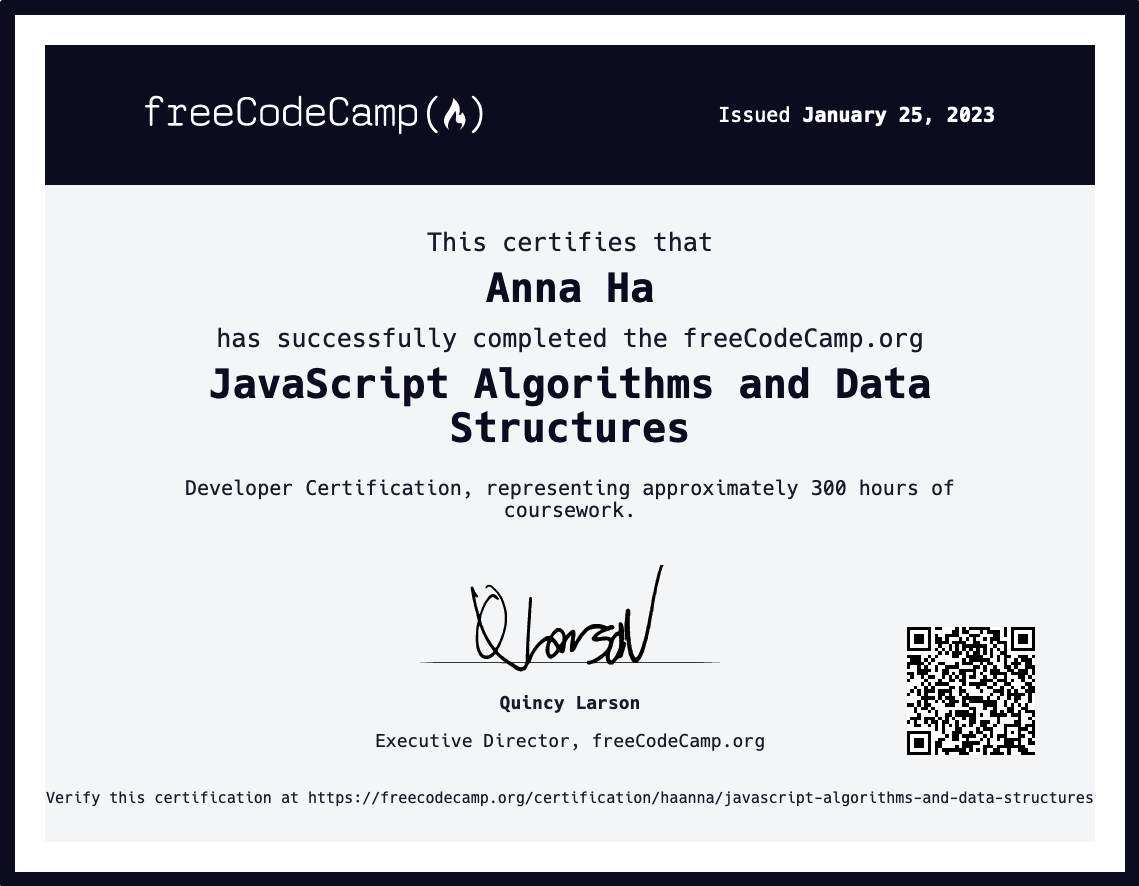All project that I've completed and that are part of the FreeCodeCamp's JavaScript Algorithms and Data Structures course can be found here.
Return true if the given string is a palindrome. Otherwise, return false.
A palindrome is a word or sentence that's spelled the same way both
forward and backward, ignoring punctuation, case, and spacing.
Note: You'll need to remove all non-alphanumeric characters
(punctuation, spaces and symbols) and turn everything into
the same case (lower or upper case) in order to check for palindromes.
We'll pass strings with varying formats, such as racecar,
RaceCar, and race CAR among others.
We'll also pass strings with special symbols,
such as 2A3*3a2, 2A3 3a2, and 2_A3*3#A2.
Convert the given number into a roman numeral.
Roman numerals Arabic numerals
M 1000
CM 900
D 500
CD 400
C 100
XC 90
L 50
XL 40
X 10
IX 9
V 5
IV 4
I 1
All roman numerals answers should be provided in upper-case.
One of the simplest and most widely known ciphers is a Caesar cipher,
also known as a shift cipher. In a shift cipher the meanings of the
letters are shifted by some set amount.
A common modern use is the ROT13 cipher, where the values of the
letters are shifted by 13 places. Thus A ↔ N, B ↔ O and so on.
Write a function which takes a ROT13 encoded string as input and
returns a decoded string.
All letters will be uppercase. Do not transform any non-alphabetic
character (i.e. spaces, punctuation), but do pass them on.
Return true if the passed string looks like a valid US phone number.
The user may fill out the form field any way they choose as long as
it has the format of a valid US number. The following are examples
of valid formats for US numbers (refer to the tests below for other variants):
555-555-5555
(555)555-5555
(555) 555-5555
555 555 5555
5555555555
1 555 555 5555
For this challenge you will be presented with a string such as
800-692-7753 or 8oo-six427676;laskdjf. Your job is to validate
or reject the US phone number based on any combination of the
formats provided above. The area code is required. If the country
code is provided, you must confirm that the country code is 1.
Return true if the string is a valid US phone number; otherwise
return false.
Design a cash register drawer function checkCashRegister()
that accepts purchase price as the first argument (price),
payment as the second argument (cash), and cash-in-drawer (cid)
as the third argument.
cid is a 2D array listing available currency.
The checkCashRegister() function should always return an
object with a status key and a change key.
Return {status: "INSUFFICIENT_FUNDS", change: []} if
cash-in-drawer is less than the change due, or if you
cannot return the exact change.
Return {status: "CLOSED", change: [...]} with cash-in-drawer
as the value for the key change if it is equal to the change due.
Otherwise, return {status: "OPEN", change: [...]}, with the change
due in coins and bills, sorted in highest to lowest order,
as the value of the change key.
Currency Unit | Amount
Penny | $0.01 (PENNY)
Nickel | $0.05 (NICKEL)
Dime | $0.1 (DIME)
Quarter | $0.25 (QUARTER)
Dollar | $1 (ONE)
Five Dollars | $5 (FIVE)
Ten Dollars | $10 (TEN)
Twenty Dollars | $20 (TWENTY)
One-hundred Dollars | $100 (ONE HUNDRED)
See below for an example of a cash-in-drawer array:
[
["PENNY", 1.01],
["NICKEL", 2.05],
["DIME", 3.1],
["QUARTER", 4.25],
["ONE", 90],
["FIVE", 55],
["TEN", 20],
["TWENTY", 60],
["ONE HUNDRED", 100]
]
- Vanilla JavaScript
DSA, Object Oriented Programming and Functional Programming
Thanks Free Code Camp for delivering all those lessons and great projects!
